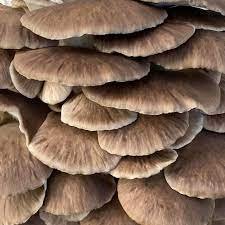Phoenix Oyster Fruiting Conditions
Time to Colonize 7-14 days – time to fruit 7 – 14 days – side fruit in bags
Phoenix oyster mushrooms are a fast-growing, edible mushroom species that are prized for their delicate flavor and tender texture. Here are some of the ideal fruiting conditions for Phoenix oyster mushrooms:
Temperature: Phoenix oyster mushrooms prefer temperatures between 70-80°F (21-27°C) for optimal growth and fruiting.
Humidity: High relative humidity (85-95%) is necessary to maintain moisture levels and prevent the fruiting bodies from drying out.
Light: Phoenix oyster mushrooms do not require direct sunlight, but do benefit from exposure to light. This helps to regulate the mushroom’s circadian rhythm and trigger fruiting.
Carbon Dioxide (CO2) levels: The ideal CO2 level for Phoenix oyster mushroom cultivation is between 1000-1500 ppm.
Airflow: Good air circulation is important to prevent the buildup of harmful gases and to distribute fragments of the mushroom’s mycelium evenly.
Substrate: Phoenix oyster mushrooms can be grown on a variety of substrates including sawdust, straw, and coffee grounds.
By maintaining these conditions, Phoenix oyster mushrooms can fruit and produce clusters of white to light-grey fruiting bodies with a delicate flavor and tender texture that are highly sought after by mushroom cultivators and gourmet chefs.
Buy A Phoenix Oyster Mushroom Grow Kit Today
Phoenix Oyster Fruiting Temperature
The optimal fruiting temperature range for Phoenix oyster mushrooms (Pleurotus pulmonarius) is 70-80°F (21-27°C). It is important to maintain a consistent temperature within this range to ensure proper growth and fruiting of the mushrooms. If the temperature is too low, fruiting may be delayed or inhibited, and if it is too high, it may lead to poor quality fruit or increased risk of contamination.
Phoenix Oyster Fruiting Humidity
The optimal relative humidity for fruiting Phoenix oyster mushrooms (Pleurotus pulmonarius) is between 80-95%. High humidity levels are necessary to prevent the mushrooms from drying out, and to encourage proper development and growth. Maintaining proper humidity levels can be achieved through regular misting of the growing environment, and by controlling the amount of air exchange. If the humidity level is too low, the mushrooms may become dry and stunted, and if it is too high, it may lead to increased risk of contamination.
We Have Only The Best Phoenix Oyster Mushroom Liquid Culture Available
Try Our Phoenix Oyster Mushroom Ready to Fruit Blocks Now
Phoenix Oyster Fruiting Lighting
Phoenix oyster mushrooms (Pleurotus pulmonarius) do not require high levels of light for proper growth and fruiting, and in fact, exposure to direct sunlight can be harmful. Low to moderate levels of indirect light are sufficient. The growing environment should be well-lit, but not exposed to direct sunlight or bright lights. During the fruiting stage, it is beneficial to provide the mushrooms with 12-16 hours of light per day to encourage growth and fruiting. Light can be provided by natural or artificial sources, such as fluorescent lights, LED lights, or windows. It is important to maintain consistent lighting conditions throughout the growing process to ensure high quality yields and prevent contamination.
We Have Only The Best Phoenix Oyster Mushroom Liquid Culture Available
Check Out Our Phoenix Oyster Mushroom Spawn
Phoenix Oyster Fruiting Co2
Phoenix oyster mushrooms (Pleurotus pulmonarius) require proper carbon dioxide (CO2) levels to thrive and produce a high yield of fruit. During the fruiting stage, CO2 levels should be kept below 1,000 ppm (parts per million) to allow for adequate fruiting. High CO2 levels can inhibit fruiting and lead to poor yields. Good air exchange and ventilation can help maintain the proper CO2 levels in the growing environment. In a home or small-scale setup, it is usually not necessary to actively control CO2 levels as long as proper air exchange is maintained. However, in larger commercial operations, CO2 levels may need to be monitored and adjusted to optimize fruiting.
Phoenix Oyster Fruiting Fresh Air Exchange (FAE)
Fresh air exchange (FAE) is important for the proper growth and fruiting of Phoenix oyster mushrooms (Pleurotus pulmonarius). Good air exchange helps to maintain optimal levels of carbon dioxide (CO2) and humidity, and helps to prevent the buildup of harmful gases and contaminants. The frequency and duration of FAE will depend on the size of the growing environment, and can be achieved through the use of fans, air pumps, or by opening and closing vents or windows. In general, a minimum of 2-3 air exchanges per hour is recommended for optimal fruiting. It is important to maintain proper FAE throughout the growing process to ensure high quality yields and prevent contamination.
Try Our Phoenix Oyster Mushroom Ready to Fruit Blocks Now
Phoenix Oyster Fruiting Lighting
Phoenix oyster mushrooms (Pleurotus pulmonarius) do not require high levels of light for proper growth and fruiting, and in fact, exposure to direct sunlight can be harmful. Low to moderate levels of indirect light are sufficient. The growing environment should be well-lit, but not exposed to direct sunlight or bright lights. During the fruiting stage, it is beneficial to provide the mushrooms with 12-16 hours of light per day to encourage growth and fruiting. Light can be provided by natural or artificial sources, such as fluorescent lights, LED lights, or windows. It is important to maintain consistent lighting conditions throughout the growing process to ensure high quality yields and prevent contamination.
We Have Only The Best Phoenix Oyster Mushroom Liquid Culture Available
